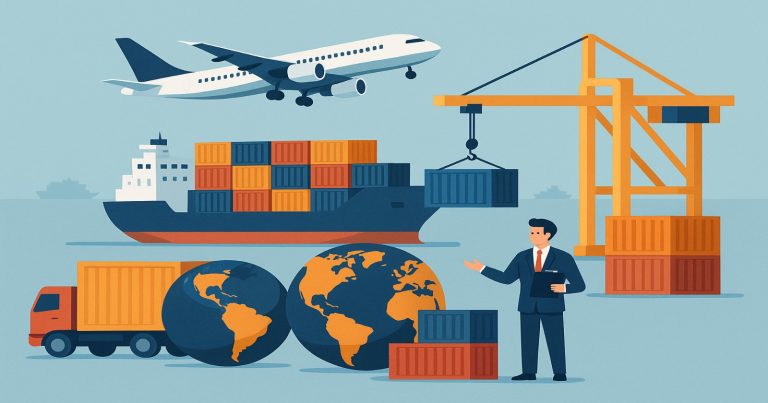Export trade refers to the act of selling goods or services produced in one country to another country. It plays a vital role in the global economy, as countries sell their goods to international markets to earn foreign exchange and boost their economies. In simpler terms, it allows businesses to expand beyond their local market, selling their products worldwide. By doing so, countries increase their income, improve their domestic industries, and open up opportunities for more jobs.
What is Export Trade?
Export trade is the exchange of goods and services across international borders. It involves businesses or governments selling products produced within one country to consumers or businesses in another country. The main objective of exporting is to earn foreign currency, create jobs, and promote national economic growth. This process helps countries develop strong relationships with other nations while increasing their overall market size beyond their domestic economy.
Characteristics of Export Trade
- International Transactions: Export trade involves transactions between buyers and sellers from different countries, which makes it an international exchange of goods and services.
- Foreign Currency Earnings: Exports help a country earn foreign currency, which it can use to pay for imports and international debts.
- Global Competitiveness: Exporting businesses need to maintain a high standard of quality and pricing to stay competitive in global markets.
- Variety of Products: Countries export a wide variety of products including raw materials, manufactured goods, and services such as education and tourism.
Importance of Export Trade
The importance of export trade extends far beyond mere economic transactions. It brings multiple benefits to countries, businesses, and consumers. Export trade can help a country grow its economy, enhance its global presence, and improve the standards of living of its people. This section discusses why export trade is vital in today’s globalized world.
Economic Growth and Development
Export trade helps generate foreign income. Countries that are successful exporters have a greater ability to purchase goods and services from other nations. They also have better access to technology and innovation, which can lead to faster economic growth and development. As a result, export trade often drives higher levels of productivity and efficiency in domestic industries.
Job Creation
The growth of export trade leads directly to more job opportunities. When a country exports more goods, there is a demand for increased production, packaging, transportation, and handling. This often translates to more people being employed in sectors such as manufacturing, logistics, marketing, and sales.
Boosts Industrial Growth
For businesses, exporting provides access to larger markets, allowing them to achieve economies of scale. Export trade helps companies grow by expanding their customer base beyond their local market. This increased demand can promote industrial expansion and encourage innovation in products and services.
Balance of Payments
A strong export trade performance can positively impact a nation’s balance of payments, improving its financial health. When a country exports more than it imports, it creates a surplus, strengthening its currency and building a more resilient economy.
Process of Export Trade
The process of export trade is complex and involves multiple steps that ensure goods are properly produced, packaged, and delivered to international customers. The export process includes everything from market research to payment collection. This section provides a detailed overview of each step involved in the export process.
Step 1: Market Research and Product Selection
Before starting export trade, businesses must conduct thorough market research. This research helps them identify which foreign markets are most suited to their products. Additionally, it helps them understand customer preferences, competition, pricing strategies, and legal requirements in those markets. Product selection is also crucial at this stage, as businesses need to ensure that they offer items that are in demand in the target market.
Step 2: Production and Quality Control
Once the market research is complete, businesses proceed with production. Exporters must ensure that their products meet the standards required in the international market. This can involve modifications in the production process, packaging, or labeling. Quality control is key at this stage, as a product’s success in the foreign market depends on its quality.
Step 3: Shipping and Documentation
The shipping process in export trade involves selecting the right transportation method (sea, air, or land) based on factors such as cost, speed, and the nature of the goods. Exporters must prepare the necessary documentation for customs clearance, including invoices, certificates of origin, and insurance. Proper documentation ensures smooth customs processing at the destination country.
Step 4: Payment and Collection
After shipping the goods, exporters must handle the payment process. Payment methods in export trade may include letters of credit, advance payments, or open account terms. Exporters must choose a payment method that reduces the risk of non-payment while still being attractive to buyers in the foreign market.
Step 5: Delivery and After-Sales Service
After payment is made, the final step in the export trade process is the delivery of the goods to the customer. At this stage, export businesses should also consider offering after-sales services such as warranty or customer support to maintain good relations and ensure customer satisfaction.
Types of Export Trade
There are several types of export trade, each catering to different needs and goals of businesses and countries. These types can be broadly classified into two categories: direct and indirect exports. Understanding the types helps businesses choose the most suitable option for their needs.
Direct Export
Direct export refers to a situation where a company sells its products directly to foreign buyers. This method involves a higher level of commitment and investment from the exporter. It often requires businesses to establish distribution channels or set up offices in foreign markets. However, direct export offers businesses greater control over pricing, marketing, and customer relationships.
Indirect Export
Indirect export involves selling products to intermediaries or export agents who, in turn, sell these products to foreign buyers. This method is suitable for companies that lack the resources to handle direct export activities. Indirect export is less risky and less resource-intensive, making it an attractive option for small and medium-sized enterprises.
Re-Export
Re-export occurs when a country imports goods from one nation and then exports them to another country without significant processing. This is common in trading hubs or countries with free trade zones, where goods flow through the country to their final destination.
Temporary Export
Temporary export refers to goods that are exported for a short period, such as machinery sent for repair or exhibition purposes. These goods are typically returned to the exporting country after the purpose is fulfilled.
Export Trade Barriers and Other Limitations
While export trade offers many benefits, it is not without its challenges. Several trade barriers can restrict or limit the flow of goods between countries. This section explores some of the most common trade barriers that affect international commerce.
Tariffs and Taxes
Tariffs are taxes imposed on imports and exports, making goods more expensive and less competitive in foreign markets. High tariffs can discourage businesses from engaging in exporting . Countries often use tariffs to protect domestic industries or generate government revenue.
Quotas
Quotas are limits placed on the quantity of goods that can be exported or imported within a given period. These restrictions often exist for specific products like agricultural goods or textiles. Quotas can limit market access for exporters, thereby affecting their ability to grow their business.
Non-Tariff Barriers
Non-tariff barriers include regulations, standards, and licensing requirements that make it difficult for exporters to enter foreign markets. These barriers often involve complex certification processes, product standards, and restrictions on certain types of goods.
Political Risks
Political instability, changes in government policies, and war can disrupt export trade. Countries experiencing political instability are often seen as risky for foreign investment, and businesses may hesitate to export to such regions.
What Is Export Policy?
An export policy is a set of guidelines and regulations that govern the export activities of a country. These policies are designed to promote export trade by offering incentives and providing a legal framework to ensure smooth international trade transactions. Export policies can include subsidies, tax breaks, and assistance programs for businesses involved in export trade.
Objectives of Export Policy
- Economic Growth: To encourage businesses to explore international markets, thereby increasing the country’s export revenue.
- Foreign Exchange Earnings: Export policies aim to help the country earn more foreign currency by expanding the export market.
- Support for Exporters: Export policies often provide financial and technical assistance to businesses, especially small and medium-sized enterprises, helping them compete globally.
- Diversification of Exports: Countries develop export policies to diversify their export base, ensuring that they are not overly dependent on a few products or markets.
Export Trade FAQs
What is export trade?
Export trade refers to the process of selling goods or services produced in one country to another country. It helps countries earn foreign exchange, boosts their economy, and creates job opportunities. It is essential for international economic relations.
What is the importance of export trade?
It is crucial for economic growth, job creation, industrial expansion, and foreign exchange earnings. It helps businesses grow by increasing their market reach and contributes significantly to a country’s economic development.
What are the types of export?
The main types of export are direct export, indirect export, re-export, and temporary export. Direct export involves selling goods directly to foreign buyers, while indirect export involves selling through intermediaries.
What are the barriers in export trade?
Barriers to export trade include tariffs, quotas, non-tariff barriers, and political risks. These barriers can make international trade difficult, and businesses must navigate them to succeed in foreign markets.
What is export policy?
An export policy is a set of regulations and guidelines designed to promote and regulate a country’s export activities. It includes incentives, subsidies, and business support programs to encourage international trade.


